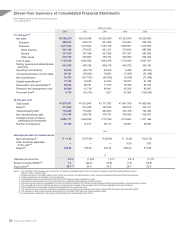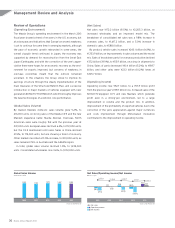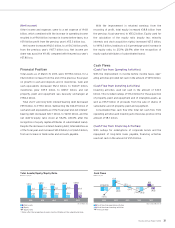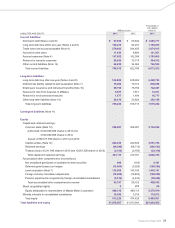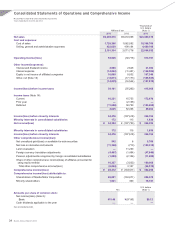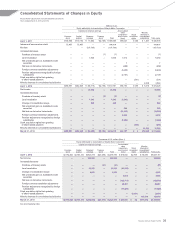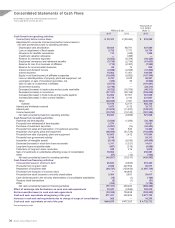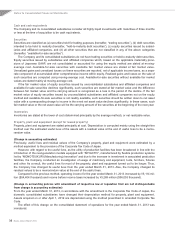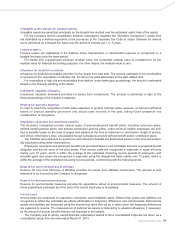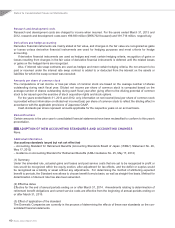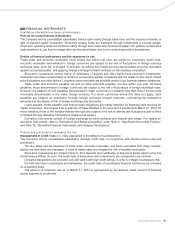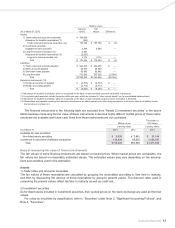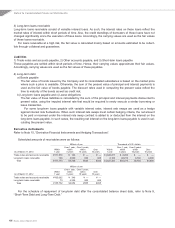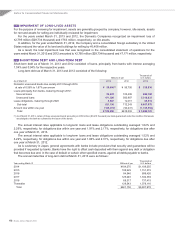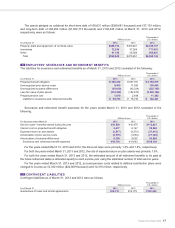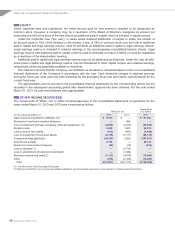Mazda 2013 Annual Report Download - page 40
Download and view the complete annual report
Please find page 40 of the 2013 Mazda annual report below. You can navigate through the pages in the report by either clicking on the pages listed below, or by using the keyword search tool below to find specific information within the annual report.
Cash and cash equivalents
The Company and its consolidated subsidiaries consider all highly liquid investments with maturities of three months
or less at the time of acquisition to be cash equivalents.
Securities
Securities are classified as (a) securities held for trading purposes (hereafter, “trading securities”), (b) debt securities
intended to be held to maturity (hereafter, “held-to-maturity debt securities”), (c) equity securities issued by subsid-
iaries and affiliated companies, and (d) all other securities that are not classified in any of the above categories
(hereafter, “available-for-sale securities”).
The Company and its consolidated subsidiaries do not have trading securities or held-to-maturity debt securities.
Equity securities issued by subsidiaries and affiliated companies which, based on the applicable materiality provi-
sions of Japanese GAAP, are not consolidated or accounted for using the equity method are stated at moving-
average cost. Available-for-sale securities with available fair market values are stated at fair market value.
Unrealized gains and unrealized losses on these securities are reported, net of applicable income taxes, as a sepa-
rate component of accumulated other comprehensive income within equity. Realized gains and losses on the sale of
such securities are computed using moving-average cost. Available-for-sale securities without available fair market
values are stated mainly at moving-average cost.
If the fair market value of equity securities issued by unconsolidated subsidiaries and affiliated companies and
available-for-sale securities declines significantly, such securities are stated at fair market value and the difference
between fair market value and the carrying amount is recognized as a loss in the period of the decline. If the fair
market value of equity securities issued by unconsolidated subsidiaries and affiliated companies not on the equity
method and available-for-sale securities is not readily available, such securities should be written down to net asset
value with a corresponding charge to income in the event net asset value declines significantly. In these cases, such
fair market value or the net asset value will be the carrying amount of the securities at the beginning of the next year.
Inventories
Inventories are stated at the lower of cost (determined principally by the average method), or net realizable value.
Property, plant and equipment (except for leased property)
Property, plant and equipment are stated principally at cost. Depreciation is computed mainly using the straight-line
method over the estimated useful lives of the assets with a residual value at the end of useful lives to be a memo-
randum value.
(Change in accounting estimates)
Previously, useful lives and residual values of the Company's property, plant and equipment were estimated by a
method equivalent to the provisions of the Corporate Tax Code of Japan.
However, with regard to the useful lives, as the utility of production facilities has been broadened in line with the
introduction of the next-generation models equipped with “SKYACTIV”, manufactured by flexible production systems
led by “MONOTSUKURI (Manufacturing) Innovation” and due to the increase in investment in associated production
facilities, the Company conducted an investigation of usage of machinery and equipment, tools, furniture, fixtures
and other. As a result, the useful lives for most of the property, plant and equipment turned out to be longer. Thus,
the Company has changed its useful lives from the year ended March 31, 2013. Also, the Company changed its
residual values to be a memorandum value at the end of the useful lives.
Compared to the previous method, operating income for the year ended March 31, 2013 increased by ¥5,114 mil-
lion ($54,404 thousand) and income before income taxes increased by ¥5,269 million ($56,053 thousand).
(Change in accounting policies with amendment of respective law or regulation that are not distinguishable
from change in accounting estimates)
From the year ended March 31, 2013, in accordance with the amendment in the Corporate Tax Code of Japan, the
domestic consolidated subsidiaries have changed their depreciation method for property, plant and equipment.
Assets acquired on or after April 1, 2012 are depreciated using the method prescribed in amended Corporate Tax
Code.
The effect of this change on the consolidated statement of operations for the year ended March 31, 2013 was
immaterial.
Notes to Consolidated Financial Statements
Mazda Annual Report 2013
38


